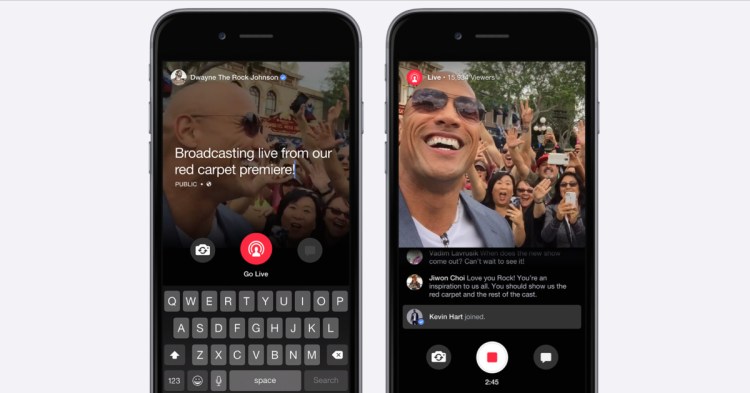For nearly the past four months, Facebook has had a live-streaming service that’s sought to rival what Periscope, Ustream, or YouTube offer. But the service has been limited to celebrities and those with verified profiles. Now, the social networking company has revealed that it’s testing its live video offering with more people.
Facebook hasn’t given a time frame for releasing this feature to the general public, but it’s not an easy thing to scale, according to a new engineering post. We do know that the company is starting with a “small percentage” of iPhone users within the U.S. If you’re one of the select few, you’ll notice a “Live Video” option in the “Update Status” dialog box within Facebook’s app — you won’t be using Facebook Mentions.
“Building live video for Facebook was a challenging exercise in engineering for scale,” wrote engineers Federico Larumbe and Abhishek Mathur. “With Live for Facebook Mentions, we had to solve for huge traffic spikes. Public figures on Facebook can have millions of followers all trying to watch a video at once; creating new tricks for load balancing became our goal.”
What’s interesting about this is that instead of starting with millions of users with relatively small audiences, Facebook instead chose a smaller group with big audiences. This obviously makes sense from a business perspective — by having thought leaders and influencers, like celebrities, using this tool, Facebook can generate more engagement and better adoption.
Preventing the “Thundering Herd”
So now that selected non-verified accounts will have access to live streaming, how is Facebook going to improve the service even further? By continuing to find ways to lower latency, of course. It claims to have already decreased latency by a few seconds, thanks to enabling what’s called RTMP (Real Time Messaging Protocol) playback, which is a system for delivering on-demand and live media.
With the incorporation of RTMP into the system, Facebook wanted to ensure the sharpest and most seamless live-streaming product on the market. Larumbe and Mathur explain that with RTMP, broadcasts are split into video and audio streams, each one further segmented into 4 KB chunks. When all is said and done, these small chunks contribute to smoother streaming across all components and reduce latency.
Prior to launching Live for Facebook Mentions, the company’s engineering team needed to deal with what’s referred to as a “Thundering Herd” problem. This occurs when too many requests hit the system at once, which could overwhelm it to the point that everyone’s live stream begins to lag, drop out, and even disconnect, causing bad experiences for all parties. Facebook was worried that this would happen with public figures like Vin Diesel.
Facebook is planning for millions of users to take advantage of live video, and while they may not have large audiences, the frequency with which they broadcast could cause problems within the network. Plus there’s the possibility of a larger-than-normal volume of users at one time. Imagine if this feature is opened to all of the social network’s 1.55 billion monthly active users and a large number of them are at a major sporting or news event and decide to live stream it to the world. What Facebook will have to deal with is not only the enormous amount of video coming in, but also the interactions that will be taking place with comments, Likes, and more.
Producing the next Facebook video star
Facebook has been making some inroads in terms of providing tools for video creators. With live broadcasting, the company is setting out to rival YouTube and increase the amount of video on its site. Who knows if the star phenomenon we’ve seen with YouTube will happen with Facebook Live. It’s already happened on Vine, as popular creators are highly sought after for sponsorships.
There are more than 8 billion daily video views on Facebook, and the eventual rollout of live streaming will certainly affect that statistic. It’ll be interesting to see what that number is next quarter or the one after that.
Facebook has not provided a timetable for the full rollout of Live for Facebook Mentions, but if this latest expansion shows positive results and doesn’t hinder the system, it could happen in 2016.
New collages for citizen journalists
If live broadcasting wasn’t enough, those that fancy themselves a citizen journalist can take advantage of a new collage feature that lets you organize your photos and videos into a scrolling, moving collage. Facebook said that you need only tap on Photo where you’ll see the most recent moments from your camera roll. They’ll be organized into collages based on when and where they were taken.
This may seem like a mimic of Instagram’s Layouts app, but it’s with movement and a different fixed structure. Collages can be edited to fit your needs. They’ll be available on iPhone today with Android support coming early next year.
VentureBeat's mission is to be a digital town square for technical decision-makers to gain knowledge about transformative enterprise technology and transact. Learn More

